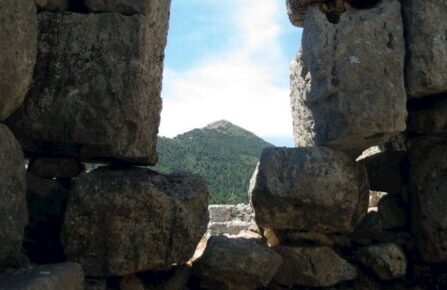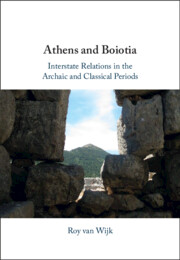
Anyone who has ever watched the Six Nations in Rugby or the World Cup in Football probably is familiar with the sentiment of beating a neighbouring country or rival brings among the faithful.
What these competitions show is how overcoming a detested neighbour in head-to-head contests can provide incomparable feelings of victory. Is this feeling of rivalry a natural sentiment that stems from proximity? And how deep does the rivalry between neighbouring countries go? Are political neighbours naturally disinclined to each other? These are questions as relevant to modern nations as they were to the Greek communities of the Archaic and Classical period and especially the Athenians and Boiotians. It is the relationship between the latter that I investigate in Athens and Boiotia. Interstate Relations in the Archaic and Classical Periods.
At the start of my research, the answer seemed a resounding ‘yes’. They were natural enemies, with a litany of evidence that refers to contested borderlands, intense hatred and monuments commemorating their wars. Our literary sources are filled to the brim with references to neighbourly conflict and mention to a troubled relationship at best. No wonder there is the prevailing idea that Greek city-states (poleis) or federations (koine) were at constant war with each other. One expression thereof can be found in a modern scholar who writes that two other neighbouring groups – the Thessalians and Phokians – hated each other ‘as only Greek neighbours could hate’. It seems to be a description apt for the lived experience of the ancient Greeks, especially since our literary sources vindicate this assessment.
But if warfare was ever-present between the two, then why are there numerous references of trade and personal ties that connect the two regions? If territorial ambitions were the guiding light of conflict, then why did disputes over contested lands only erupt after a conflict had broken out? And if their rivalry was so key in the agonistic world of the Greek communities, then why didn’t these two groups dedicate continuously at famed panhellenic sanctuaries like Delphi and Olympia, but rather at local sanctuaries and shrines?
Upon closer inspection, therefore, reality was a little more complex. Just as behind the façade of neighbourly rivalry in contemporary Europe lies an intimate web of networks that tie neighbouring countries ever closer together, so too does the source material reveal a different reality for the Athenians and Boiotians. Rather than focusing on what the literary sources explicitly say, what is left unwritten – as it were – unveils a lot more about the manner in which the Athenians and Boiotians interacted and viewed each other. Through the cracks of rivalry and seemingly teeming hostility could be found a friendly inhibition, fostered by their geographical proximity and a realisation in both regions that collaboration, in fact, was more beneficial than conflict. That is not to present a naïve, idyllic picture of peaceful co-existence briefly interrupted by insurmountable powers leading to war. That would be inane in the context of the ancient Greek world. Just as these communities were not continuously at war and only briefly interrupted by moments of peace, so too the reverse cannot hold. Life is simply not that one-sided.
Understanding the nature of our sources was essential for this shift in perspective. Instead of treating them as conveyors of the regular state of affairs, we should be viewing them as describing the exceptional times in which warfare ruled the roost. Sprinkled in between the descriptions of war and dislike were references to a continual and normal relationship that broke down on account of various factors, rather than an inveterate dislike for each other. References to personal relationship that brought these neighbouring regions together, or daily trade affairs, meant that hostilities were unhelpful and counter-productive. In fact, we see numerous attempts to avoid the possibility of war by solving quarrels via other means, such as arbitration or long-winded negotiations, as during the Peloponnesian War (431-404 BCE). Other considerations too came into play that undermine the idea that warfare was simply a given, based on a combination of rational arguments and calculated possible profits. Matters of reputation, the representation of their self-image, and trust, equally played roles in determining whether or not to go to war against each other. By analysing the relations over two centuries through this different lens, it became clear that neighbourly hostility was far from a given. Instead, it was the negative result of a longer process that slowly eroded the mutual bonds that tied the Athenians and Boiotians together.
The same applies to these borderlands. Often viewed with a modern understanding of territoriality, it seemed as if desirable and fertile lands led to conflict, with each neighbour desiring to control the fruits of the land fully. The longer term scope I used in the book, however, showed that most – if not all – of the time, the question of who controlled these borderlands was less of an issue. They could easily be co-exploited. It was only during times of conflict that these lands could suddenly be used to obtain a better position in negotiation or to actually return to the status quo of communal use of the lands.
This brings me to the remembrance culture existent in both Boiotia and Athens. In light of the assumed hostility and rivalry, it seems a given that panhellenic shrines like Olympia and Delphi were primary theatres to display that relationship. The cupboard is relatively bare, however, especially considering the abundance of material stemming from these sanctuaries. The two protagonists of my study instead focused their efforts on local sites and temples, like the Herakleion at Thebes or the Athenian Akropolis. This emphasis undoubtedly meant that the audience for these memorials was more limited. It also reveals something about the purposes of these monuments: they were aimed at strengthening the local identity, which prospers by posing it against someone else. And who better to choose than the familiar neighbours just north or south? This means that these monuments were not some vestigial mementos of the long-standing fraught relationship with the neighbours. Instead, these aimed to firmly delineate the local identities and self-worth vis-à-vis others. That could have captured an element of neighbourly rivalry, but they never steep to any level that can be termed ‘hatred’.
In the end, I was reminded of an old Dutch idiom that holds ‘a good neighbour is better than a far-away friend’. The same applied to the Athenians and Boiotians. Although they may not have been the best of friends at times, and conflict did taint their relationship in the Archaic and Classical period, there was nevertheless an understanding that a stable co-existence was more mutually valuable. It was that idea that permeated their political and military interactions and expressed itself in the arrangements made over the borderlands or even in their commemorative culture. A new interpretation of these neighbourly relations also brings with it the chance to revisit other similar situations in the ancient Greek mainland and hopefully shed a fresh glance at how we interpret interstate relations in Archaic and Classical Greece.

Athens and Boiotia
by Roy van Wijk
Latest Comments
Have your say!